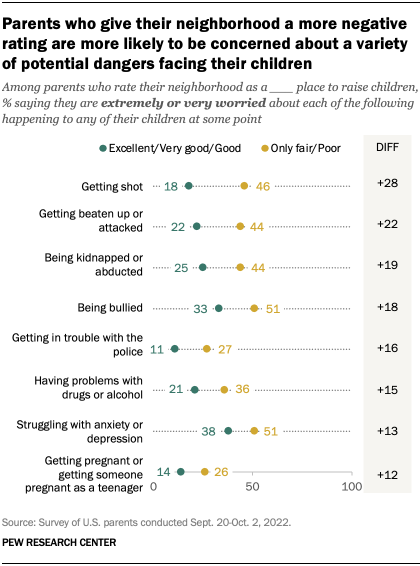Leadership
A Start To Healing Rampant Crises Of Confidence: Focus On Making Places Safer
Running through the present, even scoping to a close-up on homebuilders' Spring Selling season – with countless sources in the past and countless future destinations – streams a stack of crises of confidence, riding piggy-back on one another.

With the ongoing crush of excitement today, the instinct is to step back from the news cycle fray, listen and look at what may run through and past that maelstrom that's worth attention.
Still, that's no mean feat.
For what isn't happening fast and furious in this multi-headline daily news cycle, with the rocket-fuel of social media feeds flowing into and out of every financial, social, geo-political, environmental, scientific, and cultural development?
"Is this time different?" is now almost a naive, quaint thing to wonder. Of course it is.
"The Wisdom of the Crowds" author James Surowiecki writes in The Atlantic about social media as a come-lately shaper of financial outcomes that can impact economic consequences:
The obvious answer is for people to be skeptical of what they read, especially when it comes from sources they’re unsure of, and to not make decisions or leap to conclusions on the basis of random tweets. And that’s obviously correct in principle ... social media is built, in some respects, to make it hard for people to be skeptical and patient. It’s a medium that is designed to encourage herding and trend-following—which, after all, are what makes things go viral—rather than independent thought."
"The Psychology of Money" author Morgan Housel writes:
When faced with a problem, rarely do people ask, “What is the best, perfect, answer to this question?”
The more efficient question is often, “What answer to this question can I obtain with the least amount of effort, sacrifice, and mental discomfort?”
The psychological path of least resistance.
And then there's Yogi.
Baseball is ninety percent mental. The other half is physical."
Running through the present, even scoping to a close-up on homebuilders' Spring Selling season – with countless sources in the past and countless future destinations – streams a stack of crises of confidence, riding piggy-back on one another.
If we were, as Morgan Housel says happens so rarely, to come up with "the best, perfect answer to this question" it might be this.
Let's help to make people's lives safer."
It's primal.
And it's a value that hardly needs marketing. Still, it's an answer that raises the feeling of "effort, sacrifice, and mental discomfort."
Every year, real estate and personal financial advice website Smart Asset publishes a scorecard ranking America's safest and least safe cities.
The National Association of Realtors’ annual survey of homebuyers from 2022 found that nearly half of all buyers (49%) cited the quality of a neighborhood as the No. 1 factor for determining where to live, ahead of both affordability (37%) and proximity to friends and family (37%).
That's the data across 100 cities, and yet a primal crisis of confidence plays out in neighborhoods and communities in all of them.
A Kiplinger's article on the list notes:
Location is a key factor that people consider when buying a home. Most people take into account nearby schools, restaurants, transportation options, and importantly, the safety in their prospective location. Whether or not an area is safe is likely to be a deal breaker for home buyers. Let's face it, no one wants to live in a neighborhood with high crime rates.
A new Pew Research Center survey finds that:

More than one-in-ten parents (14%) say their neighborhood is only a fair or poor place to raise kids, and these shares of parents have higher levels of worry for their children’s well-being.
For example, 46% of parents who give their neighborhood only a fair or poor rating say they are very or extremely worried about their children getting shot at some point, compared with a far smaller share (18%) of parents who say they live in a good, very good or excellent area. Similarly, among K-12 parents who aren’t home-schooling their children, 53% who give their neighborhood only a fair or poor rating are extremely or very worried about a shooting ever happening at their child’s school. This compares with 28% of parents who rate their neighborhood more positively.
The news cycle, and the accelerant of social network feeds, as Surowiecki writes, "makes it hard to be patient and skeptical," and discourages "independent thought."
Patience would peel back some layers of confusion, noise, and chaos to see that one of human life's prized eternal values, safety, is under siege. Uncertainty, doubt, insecurity, and threat are everywhere, all at once.
People whose livelihoods – from the moment they wake up until they're settling down for the night – stem from making homes and neighborhoods for themselves and other people offer what Morgan Housel would call the "best, perfect answer to this question."
They offer more people improved safety in their homes and lives. It's an opportunity to step out of the whipping crosscurrents of topicality, and focus on a timeless need that can be met, starting yesterday and improving today.
MORE IN Leadership
10 Bold Ideas Tackling Housing Affordability And Access Now
From AI to hempcrete, these 10 ideas show how innovation in design, finance, and policy can open the door to housing affordability.
Sumitomo Forestry Sharpens U.S. Focus With DRB Move
Strategic clarity replaces portfolio sprawl as Sumitomo bets big on U.S. scale and integration.
Homebuilders and Insurance: A New-Reality Cost To Stay Ahead
Exclusive insights from Westwood Insurance Agency’s Alan Umaly and MSI’s Naimish Patel reveal why homebuilders must rethink insurance, resilience, and risk management—or risk losing buyers in an increasingly volatile market.
